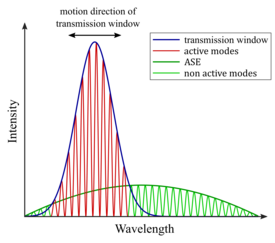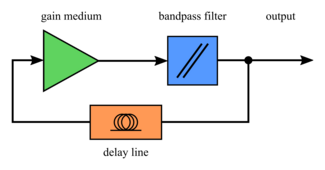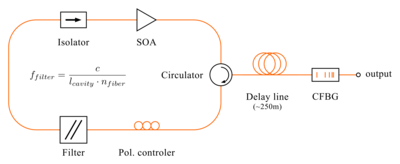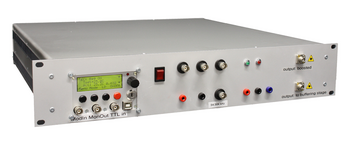The principle of the Fourier Domain mode-locked (FDML) laser, developed by Prof. Dr. Robert Huber et al., enables us to build the world's fastest narrow-band tunable laser light sources. Tuning rates of several million Hertz at optical bandwidths of more than 100 nm can be achieved. In the field of optical coherence tomography (OCT) with tunable light sources (SS-OCT), FDML lasers have revolutionized imaging. FDML lasers are able to store complete frequency sweeps in the cavity and thus keep several laser modes active simultaneously compared to conventional frequency tunable light sources. This results in an extremely low-noise sequence of frequency sweeps with a light field of particularly long coherence length. Especially in OCT, this results in a lower decrease of sensitivity with the penetration depth (roll-off) and especially low-noise images.
Current standard high-speed, frequency-swept laser sources typically consist of a broadband gain medium with a tunable optical bandpass filter in the cavity (Fig. 1).
The maximum achievable frequency tuning rate is limited by the characteristic time constant for building up laser activity inside the cavity (Fig. 2).
This non-stationary operation, corresponding to a temporally varying distribution of energy between the longitudinal modes of the laser cavity, has many drawbacks, including increased amplitude noise, low power, broad instantaneous linewidth or short instantaneous coherence length. These problems can be overcome by extending the laser cavity and periodically driving the optical bandpass filter synchronously with the optical round-trip time of the propagating light wave in the cavity (Fig. 3).
This produces a quasi-stationary operation where light from one frequency sweep propagates through the cavity and returns to the optical bandpass filter at the exact time when the transmission of the filter is at the same spectral position. In the frequency domain, this produces a fixed phase relation between the longitudinal cavity modes such that the transient electric field at the optical bandpass filter has only frequency components that match the transient filter transmission, while all other frequency components destructively interfere. We refer to this technique as Fourier domain mode locking (FDML). FDML is complementary to standard mode locking. In FDML, the spectrum, rather than the amplitude of the field, is modulated. A dynamic spectral window function (wavelength window which changes in time), rather than a temporal one (time window with no wavelength dependence), is applied. As a result, the laser generates a sequence of narrowband optical frequency sweeps at the cavity repetition rate or a harmonic thereof. This frequency-swept output can also be thought of as a sequence of highly chirped, long pulses, with a fixed phase relationship between successive frequency sweeps.
A configuration well suited for FDML operation incorporates a semiconductor optical amplifier (SOA) as a laser gain medium, a tunable Fabry-Perot filter as optical band pass and a several hundred meter length of optical fiber to provide sufficient delay.
Publications about the operation of the FDML laser can be found in the publication list.
















